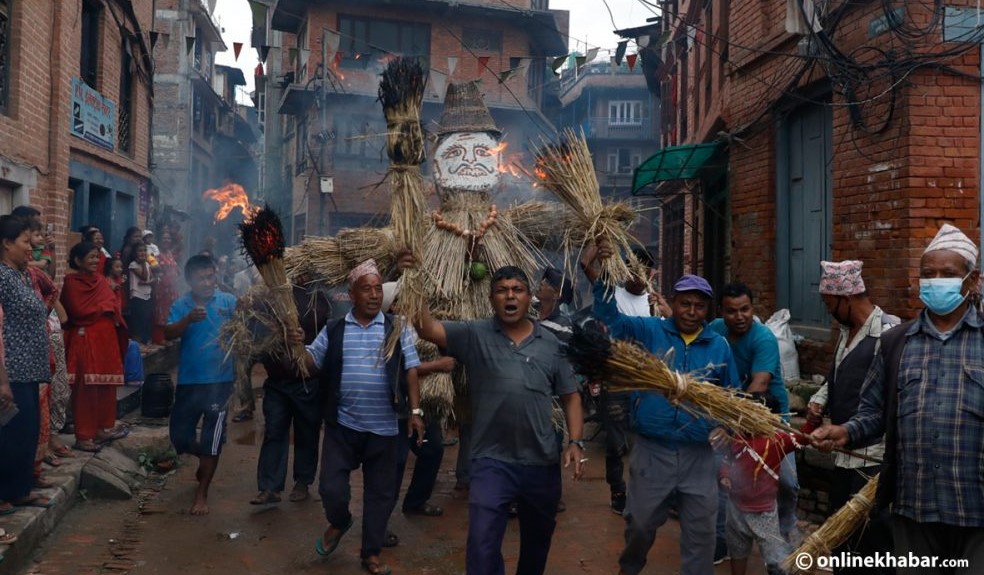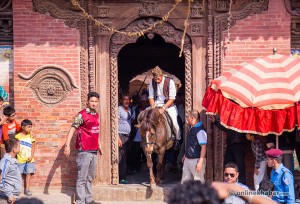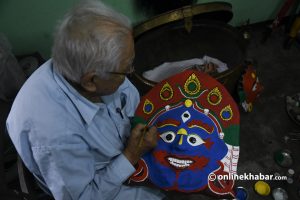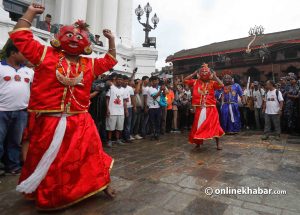Today, the Newa community is celebrating Gathamuga, also spelt as Gathemangal, a local festival. Every year, Shrawan Krishna Chaturdashi (the 14th day of the waning moon in the Shrawan month) marks the festival. It is also known as Gathamuga Chahre or Ghantakarna Chaturdashi.
This is also considered the festival of keeping one’s house or surroundings clean and performing puja to ward off evil spirits.
It is yet to be ascertained when the festival started being marked. However, the earliest mention of the festival being celebrated has been found in the Gopal Raj Vamshavali, a handwritten manuscript that mentions the festival started in the Lichhavi era.
For the occasion, people in various communities gather together to burn a straw effigy of a demon, Ghantakarna. That is the most basic part of the festival. However, there are other interesting pieces of information about the demon and the festival.
Here are a few key things:
What happens on the day of Gathamuga
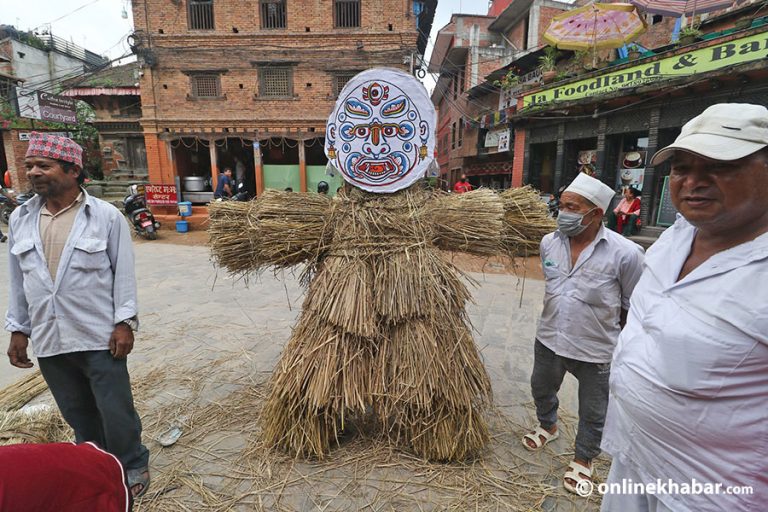
People make a human-sized effigy out of straws/hay, and bamboo, in the form of a demon. The demon is put up at crossroads and burnt at the end of the day.
People offer cooked rice or beaten rice along with rice husk and raw buffalo lungs as well as a special kind of flower called dronapushpa (Leucas cephalotes). Some also hang up dolls to burn along the effigy. Some people take the burning of an effigy as the burning of the demonic presence or the end of the yearly duty of the helpful demon.
In the evening, a person also roams around the community with paints all over his body, taking the form of a demon. He is flanked by a person holding a torch and many others who follow him around. He goes around the locality to beg for food or donation.
People give him dahi chiura (a mixture of yoghurt and beaten rice). After that, the man reaches near the effigy and goes around it three times. Once he is done, the people then pull the effigy to the nearest river, burn it and throw it into the river. The ritual is known as ‘aaju dya ha’.

Inside the houses, people perform a small puja and prepare a lit makal (earthen utensil) with coal and other herbs, three-headed nails and squared charms with mantras to ward off the evil spirits. A paper is nailed down at the top of the entrance of the house and rooms, followed by the fanning of makal inside the room. Homeowners also put together rice, spices, garlic, raw meat, and flower, to offer to the spirits and keep them outside the home. This is called ‘bau wayegu’.
On Gathamuga, people also wear iron rings on this day as they believe iron keeps evil spirits away and eat samaybaji.
Some other communities also worship Kumar Kartikeya, the firstborn of Lord Shiva and Goddess Parvati.
Stories around the Gathamuga festival
There are a few variations of stories around the Gathemuga festival.
1. It is said that in ancient times, the Kathmandu valley saw a decline in the number of farmers working in the field. In one monsoon season, a group of people performed some tantric rituals and prayed for supernatural help. But, the demons who came to help needed a lot of food and started wreaking havoc in the village. So the villagers collectively chased the demons away to the river.
Now, at the end of the plantation season, the people performed the rituals to chase the evil spirits away from the house. In another version, people mark the day to thank the demons for their help.
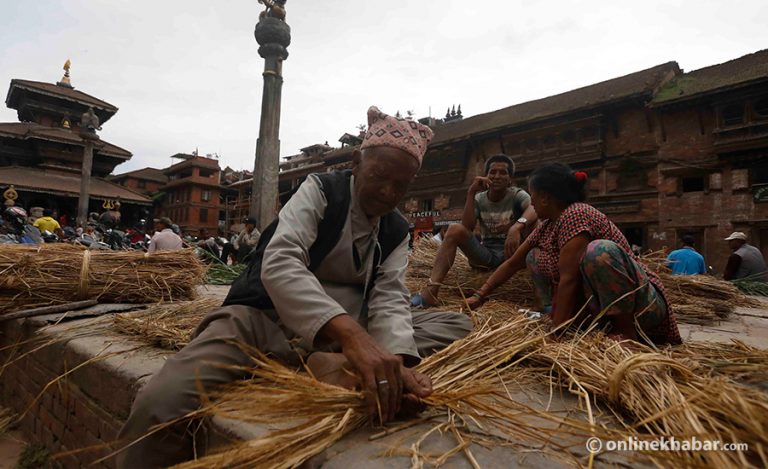
2. In the heart of the city, there was a demon that was terrifying the residents there. The demon was known as Gathamuga or Ghantakarna for it wore a pair of bells dangling from its ears.
Another local version of the story famous in Itumbahal of Kathmandu also refers to the demon as Gurumappa. Because the demon was invited to the community and told to eat whatever was available on the roof of the houses, it started eating the children sleeping on the roof.
The people wanted to get rid of him and hence they prayed to the gods. As if hearing their prayers, a group of frogs came to the locality and then started croaking to irritate the demon. The demon ran after them and when the frogs jumped into a swamp, the demon followed and then drowned in the swamp itself. So, Gathamuga is celebrated as the day people got rid of the demon.
The frog, in another version of the same story, has been believed to be a tantric who takes the form of a frog and saves people from the demon’s violence.
Based on this story, another festival byaa jaa nakegu (feeding rice to frogs) is also observed on the next full moon day where people offer frogs rice from their harvest. Others also offer panchamrit (five elements of elixir/nectar), flowers, kwati, and beans.
3. In another story related to Gathamuga, the demon is considered a protector of the people. In this version, it has been renamed Sambar Bhairav, one of Lord Shiva’s warriors. Here, Gathamuga or Ghantakarna has been defined as a protector of the Kathmandu valley, who saves the inhabitants from tantric influences. And for that, the people worship him and offer him food he likes so that he continues to protect them. It is believed that the demon had died this day, and people perform all the funeral rites for him.
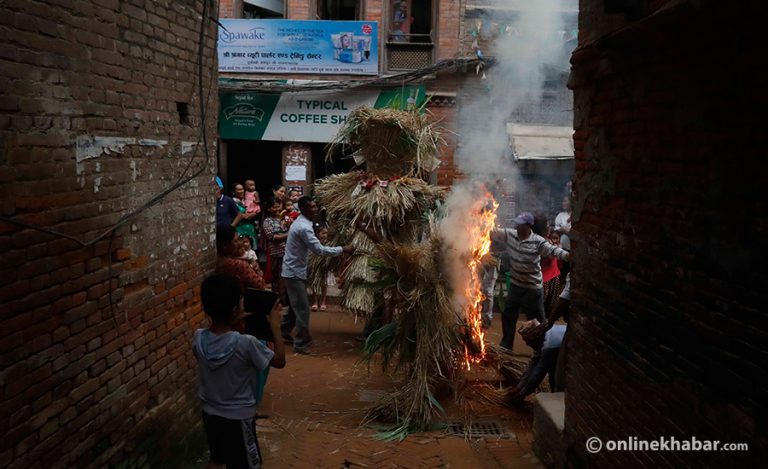
4. In Bhaktapur, Gathamuga is not a demon but a man who sat at the crossroads and took money from the rich and gave it to the poor. When the rich people refused, he killed them. When the man died, he had bells hanging from his ears. Then, people collected money for his cremation as an acknowledgement of his work.
5. According to historian Hari Ram Joshi, Gathamuga refers to the work of tying strong knots around junctions of pillars of the houses and keeping the foundation strong too. The ritual of tying the knots around the wooden pillars to make the chariot of the Rato Machhindranath is also called Gathamuga.
His interpretation of the story also says that the festival gives the message to stay united and live in harmony for the well-being of an individual, society and the nation.
Other things to know
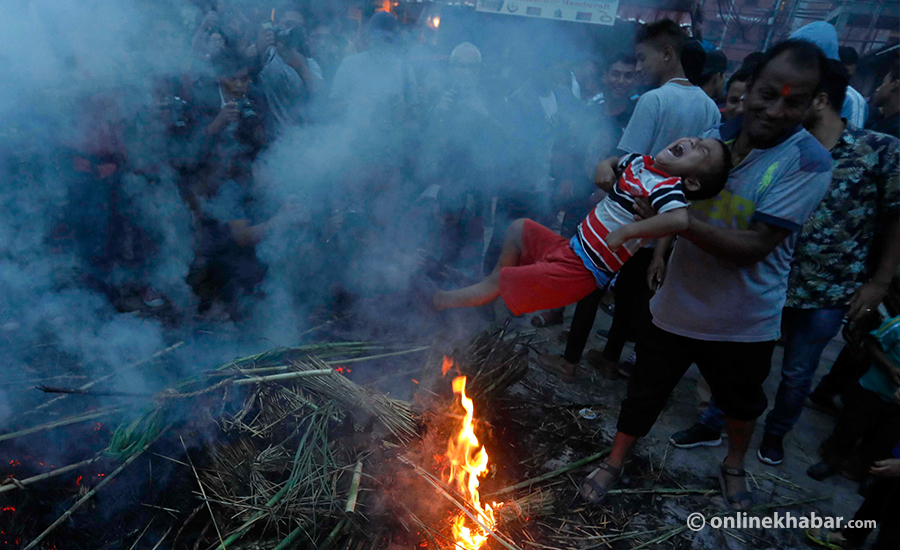
1. Gathamuga or Gathemangal ends the seven-week period starting from Sithi Nakha when the musical instruments are barred from playing.
2. The end of Gathamuga also marks the start of other yearly festivals too, starting from Gunlaa, Panchdaan, Indra Jatra and so on.
3. The men of the Navadurga Gana or Devgana who become deities for the Navadurga Naach wear ceremonial masks again this day. On Gathamuga/Gathemangal, the lifecycle of Navadurga starts by wearing the masks and ends on the day of Bhagashthi. In the end, the masks are burned and turned into ashes at Brahmayani near the Hanumante river.
4. Starting this day, lakhe is taken out for various processions in different places including Milpu Lakhe of Tokha.
5. Children are made to pass over the burning fire with the belief that it will keep them safe from evil spirits.
________________________________________________________________________________________________________________
Originally published on July 26, 2022.






